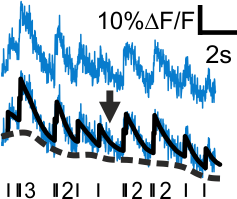MLspike

MLspike_ is an algorithm to reconstruct neuronal spiking activity from noisy calcium recordings. Its description and benchmarking can be found in (Deneux et al. 2016).
Contents
Overview
Main functions are:
| tps_mlspikes | estimate spikes from calcium (note the function spk_est, which is a small wrapper of tps_mlspikes) |
| spk_autocalibration | auto-calibration of parameters A, tau, sigma |
| spk_autosigma | auto-calibration of parameter sigma |
| spk_gentrain | generate simulated spike train |
| spk_calcium | generate simulated calcium signal |
| spk_display | display spikes and calcium signals together |
| spk_calibration | calibration, i.e. estimate the values of physiological parameters based on true spikes and recorded calcium signals |
Simulation and estimation run with parameters, default parameters are easily obtained, for example:
par = tps_mlspikes('par');`.
Help for each function can be provided by typing `help function_name`. Additional help can be found in the Help browser: type `doc`, then go to 'Supplemental Software' > 'MLspike Toolbox'.
Demo
Two demos exist:
spk_demoGUI This script runs MLspike (but not the autocalibration) on simulated data, with a graphic interface that lets user play with the simulation and estimation parameters. It provides an immediate understanding of MLspike abilities, and of how does estimation accuracy depend on the characteristics of the data and on estimation parameters.
spk_demo This script generates simulated data and runs successively the MLspike and autocalibration algorithms on it; use it to learn how to use the different functions; comments in the code indicate how to replace the simulated data by your own data. See here the script output.
A more complex script can be studied as well to better understand the algorithms:
spk_factorbox This script generates the factor box that is part of the manuscript supplementary material. See here the script output.